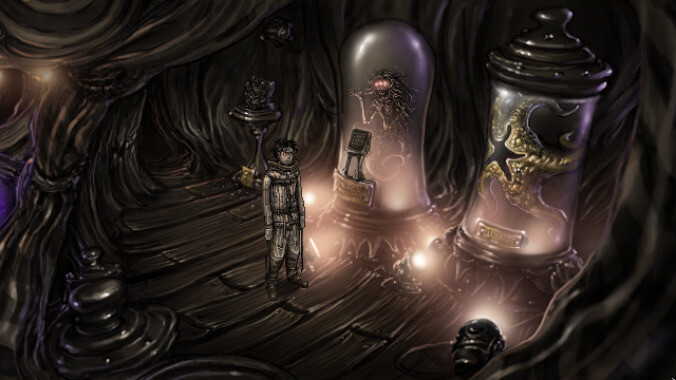Every Friday, A.V. Club staffers kick off our weekly open thread for the discussion of gaming plans and recent gaming glories, but of course, the real action is down in the comments, where we invite you to answer our eternal question: What Are You Playing This Weekend?
What is it like to know that you’re trapped in an allegory? You never really see it happen in fiction—a character in a Sartre play or whatever taking a moment to acknowledge, “Aw, fuck, I exist as a symbolic representation of a universal grief or misery, don’t I?”
Strangeland, the new graphic adventure game from Wormwood Studios and Wadjet Eye Games, comes closer than most, at least, acknowledging early and often that your doomed, scraggly-haired hero (known only as The Stranger), and his wanderings through a haunted carnival, probably aren’t a literal one-to-one with reality. It has another deviation from the works of Sartre, too: In
Strangeland, hell isn’t other people—it’s only you.
And the clowns, of course.
Again, nobody’s running a con here. This is a game where the ability to destroy yourself is present on every screen; where one of the first things you see is a woman continually tossing herself down a hole, apparently to her inevitable death. And it’s not like adventure games—so reliant on the application of Item A to Item B on the dictates of some pun or flimsy line of reasoning—don’t already have a pretty healthy chunk of dream logic lodged firmly inside their skulls. So it’s obvious from the jump that Strangeland is a game about processing…something. The death of a loved one, certainly, but also simply a sensation of decay. The game’s lurid, and frequent, cutaways to lovingly composed image of corpora decomposing, splitting apart, or simply rotting and wrong emphasize the fallibility of the flesh at every turn. But the message it transmits—right down to having the taunting clown who offers a weary gallows joke to you after every inevitable death, in the Stranger’s own voice—is that every wound you’re seeing is self-inflicted, of a sort.
That blending of arthouse—dare we say Lynchian—ambiguity, and traditional puzzle-solving, isn’t always a comfortable fit. The game’s puzzle solutions mostly fit with the theme, whether you’re negotiating with a sentient forge, or manipulating a blind and memory-free scribe into writing words of utility and power. Occasionally though, the demands of being a satisfying set of puzzles and a long-form meditation on self-destruction weigh down the theme; there might be something apt about tossing yourself into a void because you can’t figure out which sharp object you own is the right sharp object to cut open a tent flap—but it’s a despair of a much less existential sort.
The deeper issue with this trip through your own head—a metaphor that gets very literal the further into the game you get—is that the figurative language can build up in such quantities that the end result gets cluttered. Strangeland isn’t terribly long, and it’s mostly linear in its scenarios. But it tosses so many allegories at the wall that not all of them stick, no matter how dipped in ichor they get. The game’s menagerie of washed-out-colors, skeletal mermaids, and chatty carrion birds is top-of-class when it comes to establishing a tone (80 percent dread, 10 percent comedy, 10 percent whimsy), but it’s harder to tease out what, exactly, it has to say about the self-inflicted prison known as grief. That makes the game’s final confrontation, especially, feel a little hollow, as The Strange wrestles with various parts of himself over the question of whether there’s such a thing as a wound so deep that it never truly heals. (Some might argue that the ability to pull for optimism at this point rings even hollower, but some should also acknowledge that they’re a notable pessimist about this sort of thing.)
The fact that we’re here arguing about the deeper realities of loss, though, speaks to Strangeland’s uniqueness in the gaming landscape. Horrifying in parts, but never scary, it’s a thoughtful and beautiful game, one that can’t be dragged downward by a few more prosaic flaws. (Also, there’s a reasonably robust hint system if any of the more onerous puzzles get you stuck.) If you have any affection for old-school adventure games, it’s worth checking out (as is most of the rest of Wadjet Eye’s catalog, we note in passing)—and if you just want to see some extremely cool, artistically gory images, you might at least consider skimming a stream. It’s up to you, though: As Strangeland reminds us with haunting frequency, we only have ourselves to blame.


 Keep scrolling for more great stories from A.V. Club.
Keep scrolling for more great stories from A.V. Club.